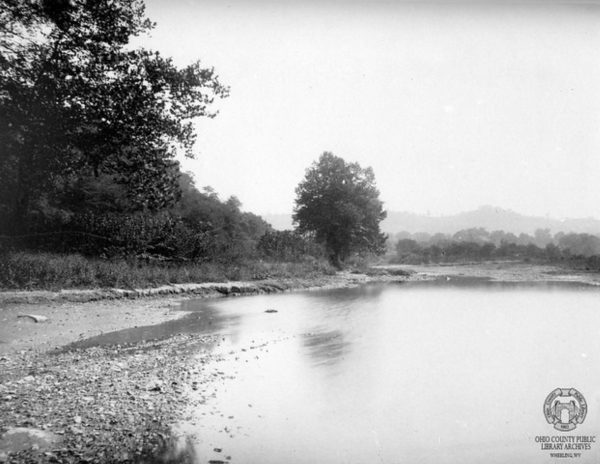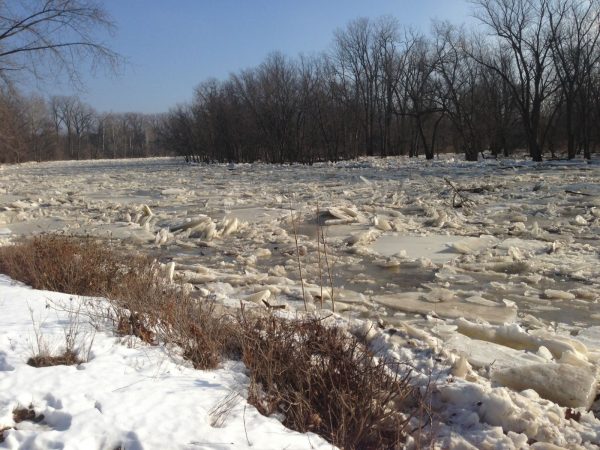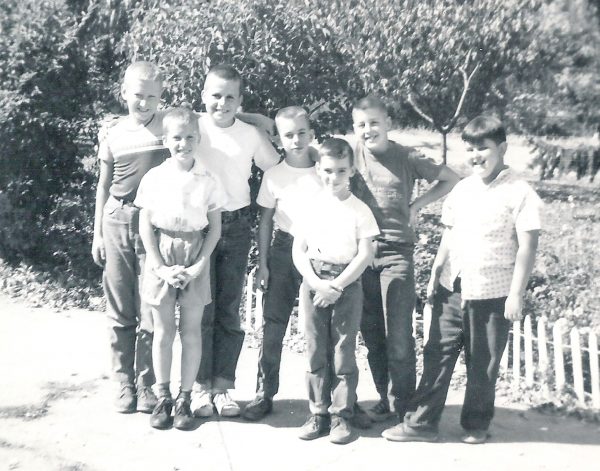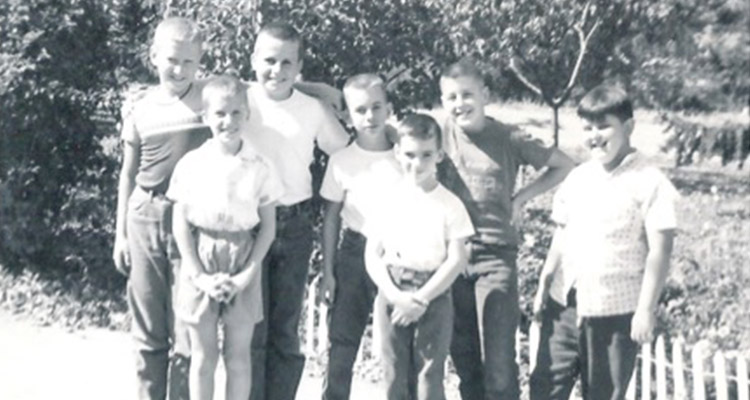The wide, often-muddy tributary with its rocks, crawdads, catfish and other wildlife was a magnet to boys. We suspected it was some sort of safety issue that led parents to try to keep us away from our forbidden-but-versatile, adventure-prone play area. We didn’t share their concerns and always gravitated to the creek when we complied with our parents’ other frequently voiced directive to “go outside and play.”
A gaggle of parked bicycles at the top of the creek bank always indicated that boys were at play down below.
On hot summer days when the water level was very low, we built bridges out of flat stepping stones that we excavated and gathered from the hillsides. We traversed those wobbly but dry stones to reach and explore the opposite creek bank, which we only visited a few times a year when dry weather allowed our bridge-building to occur. It seemed important to overcome the challenge of reaching the opposite shore with dry feet. For some reason in our still developing thought process, it didn’t seem illogical that the very next day we would think nothing of wading in the water to search for wildlife.

There wasn’t one of us who did not consider ourselves a stone-skipping artist. If you had a well-chosen flat stone, a well-placed index finger, some aggressive wrist flicking and good arm range of motion, you could skip a stone right over the water from one bank to another and establish bragging rights until the next neighborhood contestant did better. It was a miracle of physics we didn’t have to explain or understand to enjoy.
At the end of my street was a section of the creek that featured deeper water. It was our fishing area and, for the particularly hardy, a swimming hole. We didn’t swim in it often. Some of us never dared at all. The bottom was rocky and littered with unidentified refuse, which required swimmers to wear their inexpensive canvas “PF Fliers” during emersions. The water was deep green, and we couldn’t see what lay below. And we were always suspicious of those globs of yellow bubbles that occasionally floated by.
Every dip in the creek would inspire one of our adventurers to repeat the story they said they heard about how fishermen saw a giant snapping turtle in our little swimming hole. Most of us put little stock in the story even though it took on more mythical proportions with each telling. It was enough to keep most of us wary, and some of us headed for the safety of the creek bank.
 Lots of folks came by to fish in that deep-water spot. A boy named Ted was really the only neighborhood kid with the patience and curiosity to be a regular fisher. Catfish was the only thing I ever saw come out of that part of the creek. I remember Ted warning me to beware of the rear fin of a fat catfish I was going to unhook for him one day.
Lots of folks came by to fish in that deep-water spot. A boy named Ted was really the only neighborhood kid with the patience and curiosity to be a regular fisher. Catfish was the only thing I ever saw come out of that part of the creek. I remember Ted warning me to beware of the rear fin of a fat catfish I was going to unhook for him one day.
“It’s sharp as a knife and will cut you in no time,” he cautioned.
To this day, I don’t know if that is true, but from then on, he unhooked his own catfish, and I pursued alternative creek entertainment.
Above that fishing/swimming hole and just off the creek side of the road that ran parallel to the stream was a brick-lined square pit that was just big enough for a boy to stand in. It was part of the storm drain for the neighborhood. There was a hole on the creek side of the pit. It had a long iron pipe running through it that extended into the ground and came out just above the creek bank.
We could stand in that pit and throw stones through the pipe so that they would come out the other end and into the creek with a satisfying splash. The metallic noise the ricocheting rocks made as they clanged and banged their way through the pipe, and the competition we developed to see who could make a rock splash down farthest out in the water, kept us entertained for hours.
We remained fascinated by the wildlife of the creek. In addition to the catfish in the deep water, minnow fish were everywhere in the shallow areas. We took pride in our ability to capture, examine and then release the speedy crawdads that would dart from rock to rock in the low water areas of the creek.
We were always on the lookout for the dreaded garfish — the fish with a long snout and a multitude of needle-like teeth. I never saw one, but like the snapping turtle stories in the swimming hole, the gar inspired caution in our explorations because of its scary description. I never saw one in all my years of creek exploring, but other boys assured me with all sincerity that they were real, and they were out there among us — like a shark in the ocean.

When the water was high after a spring storm, we would sometimes see the occasional snake floating downstream. The sight always sent us scrambling for the safety of higher ground.
The creek bank was grassy and sloping in some places and rocky and steep in others. The diversity provided an amazing habitat for boys at play and lent itself to our versions of history and war, which were fed to us on television. We fought WW II battles, recreated Davy Crockett adventures and fought off Indian attacks. For a change of pace, we made roadways in the sand with our Tonka Toys and deployed an array of vehicles to traverse them.
In the winter, when it was cold enough for long enough, our creek would freeze. When we were certain that the ice was thick, we would venture out and slip and slide until we would hear cracks begin to develop and then make a beeline to reach the safety of the shoreline.
On snowy days, where the creek bank gently sloped downward, we rode sleds. When temperatures rose, the ice would break, creating a wonderland of angled, mangled, stacked, folded and crushed slabs of ice. I never witnessed the exact moment of the violence that created the spectacle. Sometimes you could hear it but, by the time you ran down, the magic had been done, and the once smooth and frozen surface of the water was clogged with masses of oddly shaped ice.

Occasionally, the creek would rise up and remind us that it was indeed a force of nature. Our family had a view of the creek from our kitchen window. After a prolonged hard rain, we kept tabs of the creek’s rise and its anticipated threat to the neighborhood.
The lights from Bridge Street School, just across the creek, reflected off the swift-moving waters and allowed us to judge how close the creek was coming to the road. When the water level came up, the storm sewers backed up, and our neighbors’ basements slowly but surely filled with water, ruining everything that folks were unable to move off the concrete floors.
For some reason we never figured out, our house was always spared during the floods. Neighbors to the right and left of us reported soggy basements, but not a drop ever appeared in our little house.

When I drive by the old neighborhood along Wheeling Creek these days, I never see kids at play. There aren’t bicycles conspicuously parked nearby. There are no squeals of delight heard announcing the sighting of a crawdad. There are no battles being recreated on the grassy slopes of the creek bank.
Neighborhood kids don’t fish or swim in our old spot, and nobody ruins their $140 pair of tennis shoes wading in the water.
Today, it seems the kids play inside on video consoles, are committed to time-consuming organized sports, heed the warning of their parents to stay away from the creek or just aren’t interested in the diminishing mysteries the creek has to offer. I haven’t seen a crawfish in years, skipping stones across the water is almost a lost art, and who on earth would even think about taking a dip in that tired old body of water?
Today, adults, or at least party-oriented young people, seem to have taken over our old areas. There are fire pits and picnic tables on the creek bank where our battle recreations once occurred. Empty beer cans, darkened and scorched by time spent in recreational fires, litter the pits as evidence of nighttime parties, and there are signs here and there reminding dog walkers to pick up after their pets.
Men and women in kayaks and canoes can be seen floating peacefully downstream when the waters are high enough. They appear undisturbed by the stories of giant snapping turtles and deadly garfish.
A lot has changed since the 1960s. But the waters of Big Wheeling Creek still flow, sometimes gently and sometimes aggressively, toward the Ohio River.
And, to the dismay of homeowners from Mill Acres to Leatherwood, the creek still spills over its banks and floods nearby homes.
• Gerry Griffith was born and raised in Wheeling’s Elm Grove section. He pursued a career in journalism before working on Capitol Hill for then-Congressman Alan Mollohan in Washington, D.C. He returned to Wheeling and stayed nearly 20 years to work at Wheeling Jesuit University, Touchstone Research Laboratory and in Congressman Mollohan’s Ohio County office. He also worked for the West Virginia University Research Corporation. He currently lives near Pittsburgh where he works at the National Energy Research Laboratory. He is also a contributing editor to a national industrial research publication and dabbles in fiction writing.


